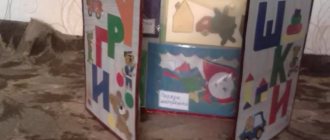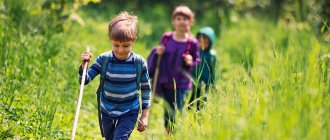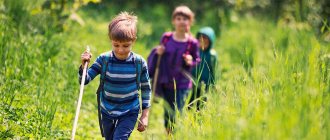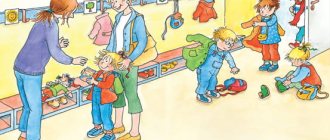Camping in the woods
Goal: to form in children an understanding of what a forest is, who lives in it and what safety rules need to be followed.
Materials: cards with images of animals and birds, cards with images of their houses.
The teacher asks the children to stand in a circle and tells them an introductory situation. The group gathered for a hike in the forest. Ask the children:
- Who lives in the forest? (animals, birds)
- What is important to take with you to the forest? (water, hat, map)
- How to behave in the forest? (watch your step, keep up with adults)
If the kids don’t know the answer to a question, the teacher tells them.
After the introductory conversation, the teacher invites the children to play a game. You need to guess who lives in which house. The teacher lays out cards with houses of animals and birds in front of the children and gives each of them several cards depicting the inhabitants of the forest. Children must find a house for everyone.
When the children have finished completing the task, the teacher explains that they should not touch these houses so as not to anger their inhabitants. After all, we don’t come to visit our friends without an invitation.
Intellectual game “Child Safety in Nature” for the older children of the kindergarten group
Kalinina Nadezhda Vladimirovna, teacher at MBDOU "Kindergarten No. 2", the city of Okhansk, Perm Territory. Intellectual game “What? Where? When?" on safe behavior of children in nature. (Senior preschool age.)
Goal: consolidation of knowledge on safe behavior in nature.
Objectives: 1. To consolidate knowledge about correct behavior in nature during a thunderstorm, when meeting wild animals and insects. 2. Expand knowledge about edible and inedible mushrooms and poisonous plants. 3. Develop children's speech. 4. Consolidate knowledge about the benefits and harms of fire.
Necessary equipment and materials: images of fairy-tale characters (Baba Yaga, Karabas Barabas, Vupsen and Pupsen, the Snow Queen, Dyudyuka, Mrs. Belodonna), images of various herbs, berries, mushrooms, dangerous situations in nature, images of insects, a black box, a rotating disk with arrow, multimedia equipment, box of matches.
Children sit at a table with a disk with an arrow on it. Around the disk are envelopes with tasks from fairy-tale characters. During rotation, the arrow points to the target.
Progress: Educator: Guys, our kindergarten received a letter from fairy-tale characters. They want to test your knowledge of safe behavior in nature. They are confident that you know nothing and they will easily win this competition against you. Do you want to win against them? (Yes.) Then rotate the arrow and select the first task.
Assignments in envelopes.
1. Baba Yaga is playing against you (on the screen there is an image of Baba Yaga under a tall lonely tree during a thunderstorm). Assignment: Guys, please tell me what I did wrong and advise me on how to do the right thing. (During a thunderstorm, you should not stand under a tree, run, talk on the phone, or hold a metal object in your hand).
2. Vupsen and Pupsen are playing against you. (Give the children pictures with different berries and herbs.) Assignment: Guys, we really love to chew grass and berries, but some of them give us stomach ache, look at the pictures - this is what we recently ate, which could make our stomachs ache and what should we do if we don’t know the edible herb or berry in front of us. (Crow’s eye)
3. The Snow Queen is playing against you. Assignment: look at the picture and say what rule of safe behavior is shown here. (When encountering wild animals, you must be quiet and carefully move away from him).
4. Black box. Dyudyuka is playing against you. She hid an object in this box and wants you to guess what is there. Assignment: There is an object hidden in the box that will help you in the forest, but on the other hand, this object can cause great trouble. Hint - riddle: This is a cramped, cramped house: A hundred sisters are huddled in it. And any of the sisters can flare up like a fire! Don’t joke with your Thin sisters... What item did Dyudyuka wish for? (Matches). How can matches help in the forest? (you can light a fire to cook food and keep warm, fire scares away wild animals). What harm can a fire cause in a forest? (if you do not put out the fire, a fire may start in the forest and all the animals may be left homeless or die). 5. Karabas Barabas is playing against you (images of mushrooms are placed in a basket). Assignment: Guys, I am a very harmful person and therefore I am giving you the most insidious task. I collected all the mushrooms that came my way in the forest. I want you to choose only edible mushrooms from the basket. Let's check if you have chosen the right mushrooms, look at the screen. (The correct answer appears on the screen.) Who can name these mushrooms? (Boletus, boletus, boletus, boletus, russula, boletus). Why are boletus and boletus called so? (Because they grow under birch and aspen).
6. Mrs. Belodonna is playing against you. Assignment: look at the pictures, what insects do you know? Which of them can be dangerous to humans? What rules for safe communication with these insects do you know? (Do not wave your hands in front of a wasp or bee, do not disturb or destroy their nests, use insect repellents). And now to sum up. You guys completed all the tasks and become winners in our competition. Which task was the most difficult for you to complete? Which task did you like the most?
Be careful, insects!
Goal: to develop in children an understanding of how to behave when encountering insects.
Materials: pictures depicting various insects.
The teacher shows the children pictures of insects. For example, ladybug, wasp, rhinoceros beetle and mosquito. The teacher asks:
- Are you familiar with these insects?
- What harm can they cause?
- Is there any way to protect yourself from them?
- What to do if you are bitten?
If the kids could not answer all the questions, the teacher prompts.
Then the teacher recites the poem, simultaneously showing the movements:
I was stung by a bee (He shows with his finger how a bee stings, and the children repeat after him) I shouted: “How could you!” (Everyone shouts together, “How could you?”) The bee responds: “How could you pick my favorite flower? (Shows how he picks a flower) After all, I really needed it: (Everyone buzzes together like bees) I was saving it for dinner!” (Show how a bee eats)
Then the teacher discusses with the children why the bee stung and how it could have been avoided. It is important to convey to children the idea that insects usually do not attack if they are not disturbed.
To reinforce the topic, the teacher conducts a quick survey with the children:
- What to do if a bee or wasp is flying near you? (don't wave your arms)
- What to do if you step on an anthill? (quickly leave this place and shake off the ants)
- What to do if you see a beetle? (pass by)
Do-it-yourself didactic safety game
Multifunctional didactic game “Your Safety”.
The goal of the game is to systematize children’s ideas about the rules of safe behavior in the environment, and to develop the ability to be attentive to their health.
Age target : for children from 4 to 7 years old.
"Your safety"
is a set of various games that are placed on a folder. Before starting the game, children choose the game they like. Games can be accompanied by poems and riddles corresponding to the theme.
Didactic game “Name the traffic rule”
Goal: strengthening the rules of the road, developing skills for safe behavior on the road .
Didactic material : cards with illustrations of traffic rules and poems.
Game actions:
• Select a card,
• Look at the illustration,
• Talk about the situation depicted,
• Formulate an appropriate traffic rule.
Didactic game - puzzle “Assemble a road sign”
Goal: to consolidate ideas about road signs. Be able to correctly name a road sign.
From the proposed parts you need to assemble a road sign and explain its meaning.
Game "Dangerous Objects"
Goal: to consolidate ideas about subjects dangerous to life and health, the ability to reason on this topic, and draw logical conclusions.
Didactic material : story pictures with images depicting dangerous objects.
Game actions:
• Select a card,
• Look at the illustration,
• Tell what is shown on the card,
• Formulate a safety .
Didactic game “Emergency phone numbers”.
Goal: developing knowledge about emergency numbers 101, 112, 102, 103, 104, about the appearance of ambulances
,
“Fire truck”
,
“Road patrol car”
,
“Gas service car”
.
Didactic material : cards with emergency phone numbers and images of special purpose vehicles.
Didactic game “Safety in nature”
Goal: consolidating the rules of behavior in nature, the idea that nature is our common home, developing the ability to independently draw up rules of human behavior in nature, the desire to protect and protect nature.
Didactic material : pictures with situations of behavior in nature.
Game "Fire is friend, fire is enemy."
Purpose: To give an idea of the benefits and harms of fire. children’s ideas about the benefits and dangers of fire, to consolidate children’s about fire-hazardous objects, about the rules of behavior in case of fire;
Didactic material : Pictures depicting fire that is harmful and fire that is beneficial.
Using images, explain in which cases fire is beneficial and in which it is harmful.
Using this game, you can teach children in a playful way how to behave safely at home, while walking, in the forest, or on the road.
Multifunctional didactic game “Your Safety”
was presented to the teaching staff of the preschool institution at the pedagogical council.
Lesson-game on life safety
Lesson-game on the topic “Man in extreme situations”
The purpose of the lesson:
In an entertaining game form, test students’ knowledge of the life safety course.
Tasks:
1. Instilling in schoolchildren the need to anticipate possible life situations at home, in nature.
2. Formation of a conscious and responsible attitude towards personal and public safety.
3. Formation of a psychological stereotype “The environment is a system that lives according to certain laws, and in order to survive, you need to know and understand these laws and use them to your advantage.”
During the classes.
1. At the beginning of the lesson, the teacher explains the goals and objectives of the lesson.
2. By drawing lots, the class is divided into two teams, captains and team names are chosen.
3. Captains select sets of task cards
1 competition
. "Warm-up"
- Why is the fire department number "01"?
Easy to remember, short number, logical to dial even in the dark
- What should you do when leaving your apartment to prevent a fire?
Turn off the lights, turn off electrical appliances
- Is it possible to break window glass at the source of a fire?
This is not possible, as the incoming air intensifies combustion.
- What should you do if the fire cuts off your way out?
Go to the back room, close the door tightly, and shout for help through the window or balcony door. Passers-by will call "01"
- Name any three reasons for the fire?
An unextinguished cigarette, playing with matches, an unplugged electric stove
- Why do people die in fires?
From smoke, fire, poisonous gases, loss of consciousness
2 competition.
"Puzzles"
- Hisses and gets angry, afraid of water. With a tongue, but does not bark, without teeth, but bites.
(Fire)
- If you feed it, it lives. If you give him something to drink, he will die.
(Fire, fire)
- Dwarves live in a wooden house; they are such good-natured people who distribute lights to everyone.
(Matches)
- My head is on fire. The body melts and burns. I want to be useful. There is no lamp, I'll shine it.
(Candle)
3 competition.
“Game situations”
(guys answer questions, show)
- Your TV lights up. Your actions? What can't you do?
I'll turn off the power and cover it with a damp blanket. Do not water with water.
- You see a man in burning clothes. What do we have to do? What can't you do?
I'll throw you on the floor and cover you with a jacket and a blanket.
Do not use a fire extinguisher
- Your clothes are on fire. Your actions? What can't you do?
I'll fall and roll on the floor
I'll cover myself with a blanket.
You can't run away.
4 competition.
“Crossword”
Guess the keyword
If you enter the correct answers horizontally, you will read the keyword in the highlighted vertical column.
Horizontal questions:
- If handled carelessly, a fire may occur.
Dangerous household appliance.
Injury that a person can receive due to careless handling of fire.
A long aid with cross bars used by rescuers to evacuate people from high-rise buildings.
Primary fire extinguishing agent.
5 competition.
"Captains Competition"
- What is evacuation?
This is an emergency exit from the danger zone during an emergency.
- What's in a fire box?
axe, shovel, fire extinguisher, gaff, and sandbox
- How should you move through a heavily smoky room?
crawling or crouching, holding onto walls.
6 competition.
“Walk over the abyss through darkness and rain”
Blindfolded and with an open umbrella, walk along a gymnastics bench, remove the blindfold and run back - a relay race. Performed by each participant.
7 competition.
“Prevent a fire”
Take out flammable objects drawn on cards (distance 5-7 m), whoever can take out the most in 1 minute. Each participant performs as many as he can within one minute.
8 competition .
“The most attentive”
Find PB violations within 2 minutes:
- The lamp is covered with fabric.
- The socket on the wall is overloaded.
The iron is on.
Electrical cable under the rug.
The curtain is too close to the stove.
The shelf hangs above the stove.
A towel hangs over the stove.
Summarizing. Winner's reward ceremony.
We end the lesson and wish you to act in life as amicably and thoughtfully as in the game. Remember: your safety is in your hands!






